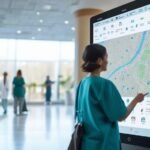Implementing a modern visitor check-in system in hospitals notably enhances security and efficiency. You'll benefit from digital check-ins using QR codes, instant badge printing, and ID scanning for precise authentication. These systems minimize unauthorized access risks and improve staff focus on patient care. Advanced software aids in enforcing COVID-19 safety measures and enhances contact tracing with real-time data. Integrating watchlists and continuous monitoring helps maintain high security standards. Hospitals adopting these systems also guarantee HIPAA compliance with robust data encryption and regular audits. Learn more to understand how these features can transform hospital visitor management.
Table of Contents
ToggleKey Takeaways
- Digital check-in systems with QR codes enhance visitor tracking and operational efficiency.
- Instant badge printing ensures accurate and professional visitor identification.
- ID scanning technology provides rapid and precise visitor authentication.
- Encrypted data transmission safeguards visitor information, enhancing cybersecurity.
- Proactive watchlists and alerts improve security by swiftly identifying potential threats.
Hospital Security Trends

In recent years, hospital security trends have increasingly focused on the adoption of digital visitor management systems to enhance safety and efficiency. Data from the ASHE 2018 Hospital Security Survey indicates that maintaining security has become 82% more challenging over the past two years. This underscores the urgent need for hospitals to embrace digital upgrades in their visitor management processes.
Currently, only 42% of hospitals utilize a visitor management system, with a noticeable shift towards digital solutions. Many facilities still rely on outdated paper logbooks, which not only compromise security but also hinder efficiency. Digital visitor management systems offer a more secure environment by accurately tracking who enters and exits the premises, thereby reducing the risk of unauthorized access.
Implementing these systems isn't just about bolstering security; it also enhances the visitor experience. Visitors can check in quickly and easily, reducing wait times and streamlining the process. This efficiency allows hospital staff to focus more on patient care rather than administrative tasks. The shift to digital visitor management systems is a vital step in modernizing hospital security and ensuring a safe, efficient, and pleasant environment for everyone involved.
COVID Visitor Restrictions
As hospitals increasingly adopt digital visitor management systems to enhance security, the COVID-19 pandemic has further necessitated visitor restrictions and the integration of advanced software solutions to guarantee safety. The urgency of covid visitor restrictions has driven the need for pre-screening processes, temperature scanning, and room capacity limits. These measures help secure a safe environment for patients, staff, and visitors, addressing evolving healthcare needs during crises.
Implementing digital check-out systems allows hospitals to track visitor movements accurately, facilitating effective contact tracing if exposure incidents occur. By adopting these visitor management systems, healthcare facilities can swiftly adapt to changing conditions, greatly improving safety measures. This approach not only minimizes the risk of infection but also maintains essential healthcare services during uncertain times.
Advanced software solutions provide real-time data, enabling hospitals to enforce covid visitor restrictions efficiently and maintain a secure environment. With features like automated alerts for capacity limits and digital check-out, these systems allow for seamless visitor flow management while prioritizing health and safety. As a result, hospitals can uphold stringent safety standards, ensuring that everyone within the facility is protected and that healthcare needs are met without compromising security.
Visitor Check-In Process
You'll find the visitor check-in process at hospitals considerably streamlined through digital solutions. By using QR codes, visitors can quickly check in and out, and instant badge printing guarantees accurate identification. This efficient system not only boosts security but also enhances overall operational efficiency.
Streamlined Digital Check-In
Hospitals are revolutionizing visitor check-ins with digital systems that allow you to scan a QR code or manually enter your information, greatly streamlining the process. This digital check-in method markedly enhances operational efficiency while providing an added layer of security. By leveraging technology, hospitals can guarantee a streamlined process that benefits both visitors and staff.
Here's what makes this system effective:
- Instant Badge Printing: Upon check-in approval, a badge is printed instantly, featuring your photo, custom details, and the hospital's logo, ensuring heightened security.
- Easy Check-Out: You can use the QR code on your badge to quickly check out, simplifying visitor tracking.
- Enhanced Security: The system tracks visitor presence in real-time, guaranteeing a secure environment.
- Operational Efficiency: Streamlining the check-in process reduces the workload for hospital staff, allowing them to focus on critical tasks.
This digital check-in system not only simplifies the visitor management process but also guarantees that security measures are robust. The seamless integration of QR codes and digital tracking mechanisms helps in maintaining a secure and efficient environment, ultimately contributing to an enhanced visitor experience.
QR Code Efficiency
Utilizing QR code efficiency in the visitor check-in process significantly enhances both speed and security for hospital premises. When visitors arrive, they can quickly scan a QR code to enter their information, bypassing manual data input. This streamlined check-in process not only reduces wait times but also guarantees that your hospital maintains an accurate record of every visitor.
QR codes facilitate digital check-out, guaranteeing efficient visitor presence tracking. By simply scanning their badge QR code when leaving, visitors can be automatically checked out, providing a clear record of who is on the hospital premises at any given time. This system bolsters secure access control, as it allows hospital staff to monitor visitor movements and ensure compliance with security protocols.
Here's a quick comparison of traditional check-in versus QR code efficiency:
| Traditional Check-In | QR Code Check-In |
|---|---|
| Manual data input | QR code scanning |
| Longer wait times | Reduced wait times |
| Paper-based records | Digital records |
| Inconsistent tracking | Accurate visitor tracking |
| Limited security | Enhanced secure access |
Instant Badge Printing
Building on the efficiency of QR codes, instant badge printing further streamlines the visitor check-in process by providing personalized badges with photos, custom details, and company logos upon approval. This advancement not only enhances security but also offers a seamless experience that integrates with digital visitor management systems. Once a visitor's credentials are verified, the system immediately prints a badge, enabling quick and efficient entry.
The benefits of instant badge printing include:
- Enhanced Security: Personalized visitor badges improve visitor presence tracking within hospital premises.
- Efficiency: The check-in process is expedited, reducing wait times and enabling faster visitor flow.
- Professional Appearance: Badges with company logos and custom details present a professional image.
- Instant Notifications: Staff receive real-time updates on visitor movements, enhancing situational awareness.
Instant badge printing also simplifies the check-out process. Visitors can use the QR codes on their badges to quickly log out, ensuring accurate records of who is in the building at any given time. This method improves transparency and accountability within the hospital environment. By leveraging digital visitor management and instant badge printing, hospitals can maintain a secure, efficient, and professional atmosphere for all visitors.
ID Scanning and Verification
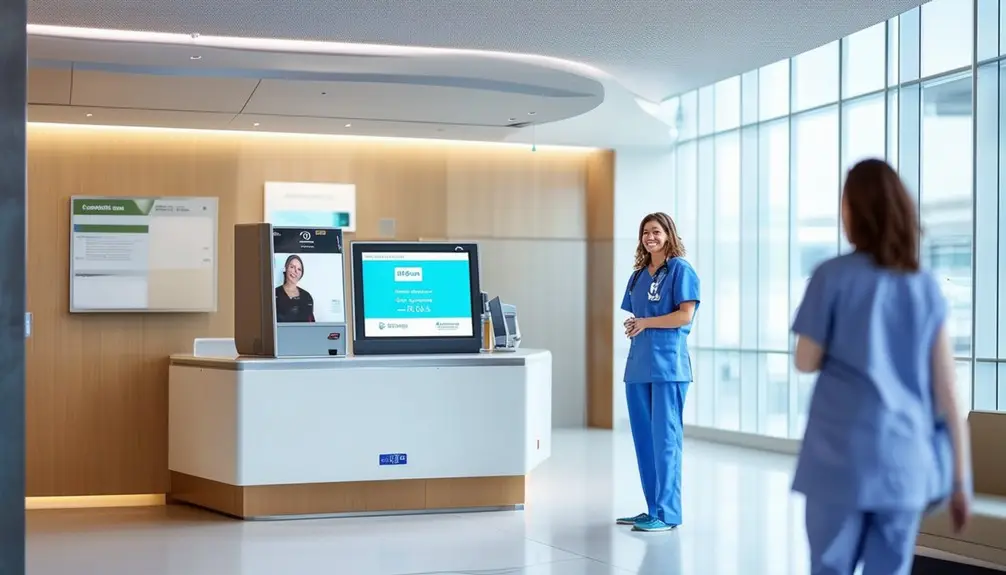
When you implement ID scanning in your hospital's visitor management system, you'll see immediate improvements in identity verification and security. This technology efficiently reads PDF417 barcodes on state-issued IDs, ensuring accurate identification and a streamlined check-in process. Additionally, encrypted data transmission with TLS 1.2 and 256-Bit AES encryption safeguards visitor information, enhancing overall cybersecurity.
Efficient Identity Verification
ID scanning technology swiftly reads PDF417 barcodes on state-issued IDs, greatly enhancing the efficiency and accuracy of visitor check-in processes in hospitals. By leveraging this technology, you can streamline visitor management, making sure that each person entering the hospital is accurately identified and their entry is securely logged.
Modern visitor management systems utilize ID scanning to make check-ins more efficient and secure. Here's how:
- Speed: Quickly captures and processes visitor information, reducing wait times significantly.
- Accuracy: Ensures that visitor data is correctly recorded, which is essential for maintaining up-to-date records.
- Security: Verifies the authenticity of IDs, adding an additional layer of security to hospital premises.
- Data Integrity: Helps maintain the confidentiality and integrity of visitor information, important in healthcare settings.
When you implement ID scanning for visitor management, you're not just improving efficiency. You're also strengthening security and ensuring accurate data collection. This approach minimizes errors and potential security risks, making it an important component in modern hospital operations. By focusing on efficient identity verification, hospitals can provide a safer, more streamlined experience for everyone involved.
Enhanced Security Measures
To strengthen security measures, hospitals use advanced ID scanning and verification systems that quickly and accurately authenticate visitor identities. These digital tools are vital to the visitor management process, ensuring that only authorized individuals gain access to hospital premises. By reading industry-standard PDF417 barcodes on state-issued IDs, hospitals can enhance their security protocols effectively.
Implementing hospital visitor management systems with sophisticated ID scanning allows for quick and efficient validation of visitor information. This not only speeds up the check-in process but also secures access control. Accurate verification minimizes risks, thereby enhancing overall safety within healthcare facilities.
| Feature | Benefit |
|---|---|
| ID Scanning | Rapid and precise visitor authentication |
| Digital Verification | Improves security protocols |
| Access Control | Confirms only authorized access |
These systems are designed to seamlessly integrate into existing security frameworks, providing a strong solution for managing visitor presence. By leveraging digital technology, hospitals can maintain a higher level of security and operational efficiency. The ability to track visitor movement accurately within the hospital premises is crucial for maintaining a secure environment. As such, incorporating advanced ID scanning and verification into your hospital's visitor management process is not just a recommendation but a necessity for modern healthcare security.
Streamlined Check-In Process
Hospitals utilize advanced ID scanning and verification systems to greatly streamline the visitor check-in process, guaranteeing both efficiency and security. By rapidly scanning state-issued IDs with industry-standard PDF417 barcode scanning, hospitals can accurately identify visitors and expedite the check-in process. This not only makes the visitor check-in process more efficient but also markedly enhances security measures.
When you visit a hospital, these systems provide:
- Streamlined visitor check-in: ID scanning speeds up the process, reducing wait times.
- Precise identification: Ensuring that only verified individuals gain access.
- Boosted security measures: Strengthens the overall security of the hospital premises.
- Dependable access control: Maintains a secure environment by controlling who enters.
With efficient ID verification, hospitals can provide a safer and more streamlined experience for everyone. The quick and reliable ID scanning process not only improves access control but also guarantees that each visitor is accurately logged and monitored. As a result, the overall visitor management process is significantly improved, contributing to a safer and more secure hospital environment. By implementing these advanced technologies, hospitals can better manage the influx of visitors while maintaining a high level of security and operational efficiency.
Visitor Badges
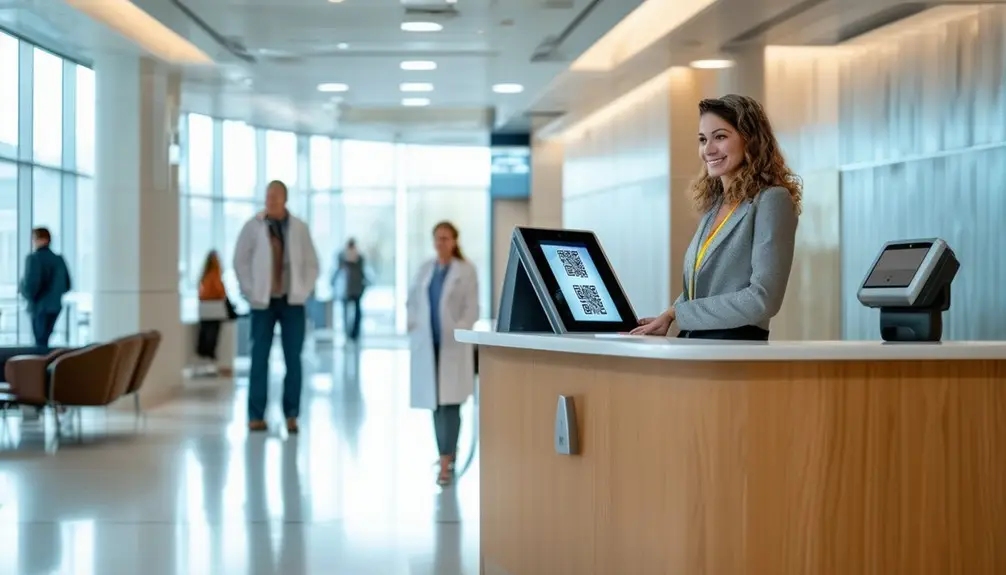
Visitor badges instantly provide a clear and secure way to identify authorized individuals within hospital settings, enhancing both safety and efficiency. By visibly marking who is permitted in specific areas, these badges play an essential role in maintaining a secure environment. The check-in process becomes streamlined as visitor badges are issued upon approval, ensuring that only authorized individuals gain access.
Customized visitor badges can include photos, hospital logos, and specific details, making identification straightforward for hospital staff. This level of customization also supports hospital branding while catering to unique security needs. The badges serve as an effective tool for access control, visibly distinguishing visitors from staff and patients.
Additionally, the implementation of visitor badges simplifies the check-in process. When visitors arrive, you can quickly issue them a badge that includes all necessary identification details. This not only speeds up the check-in process but also enhances overall visitor management efficiency. By using a standardized system for issuing visitor badges, hospitals can maintain a high level of security and organization.
Watchlists and Alerts
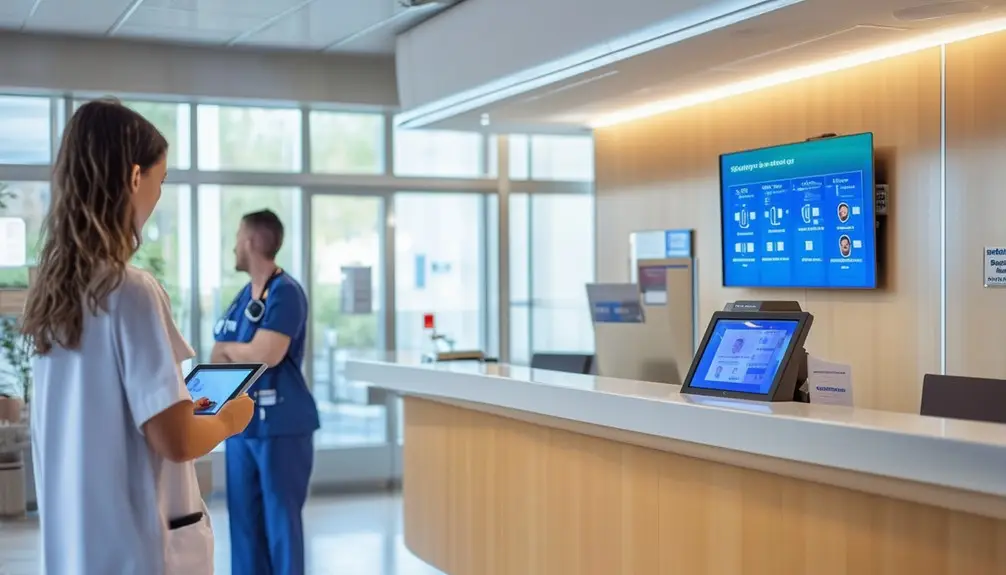
Implementing watchlists and alerts allows hospital security teams to swiftly identify and address potential risks, guaranteeing a safe environment for everyone. By running internal watchlists and conducting instant background checks on visitors, hospitals can greatly enhance their security measures. These systems improve threat detection capabilities, allowing security teams to be proactive rather than reactive.
When a visitor is flagged, an instant alert is received, enabling staff to take immediate action. This real-time monitoring is essential for maintaining a secure environment for both patients and staff. Here are some key benefits:
- Proactive threat detection: Immediate alerts for flagged visitors enable quick responses.
- Enhanced security protocols: Continuous monitoring helps maintain high security standards.
- Efficient background checks: Instant checks make sure that all visitors are screened thoroughly.
- Improved safety: Swift identification and action reduce potential risks.
Using watchlists and alerts, you can create a safer hospital environment by promptly identifying and addressing potential threats. This approach ensures that your security measures are robust, providing peace of mind to everyone within the facility. The integration of these technologies is a vital component in modernizing hospital security protocols.
HIPAA Compliance
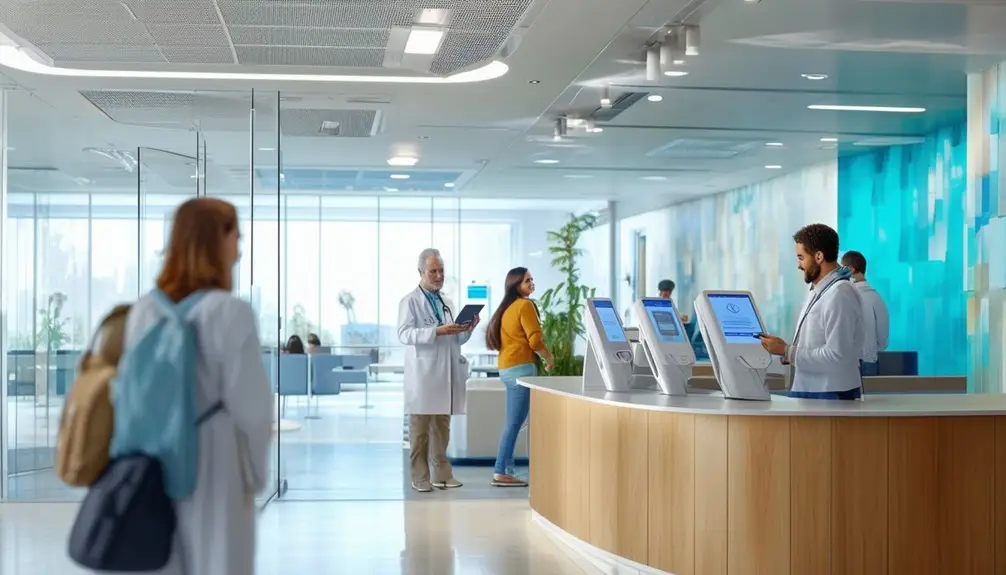
Implementing watchlists and alerts effectively also involves adhering to strict HIPAA compliance to protect sensitive patient information. You need to establish robust physical, network, and process security measures to safeguard patient data. Following HIPAA regulations not only reduces the risks of data breaches and privacy violations but also guarantees that your hospital meets legal compliance standards.
To achieve HIPAA compliance, your visitor management systems must integrate advanced encryption techniques like TLS 1.2 and 256-bit AES. These technologies secure data transmission and storage, making it extremely challenging for unauthorized parties to access sensitive information. Additionally, regular audits and staff training on HIPAA policies are essential for maintaining a high level of data security.
Frequently Asked Questions
How Do Hospitals Keep Track of Visitors?
Hospitals keep track of visitors by using digital systems. You'll scan QR codes or enter information manually, and they'll print badges with your photo. ID scanners and watchlists enhance security by identifying authorized visitors and potential risks.
What Is Visitor Monitoring System?
A visitor monitoring system is a digital solution that tracks and manages hospital visitors through digital check-ins, ID scanning, and badge printing. It provides real-time insights, alerts, and background checks to enhance security and efficiency.
Conclusion
To wrap up, modern visitor check-in systems are revolutionizing hospital security and efficiency. Did you know that 87% of hospitals report improved visitor management with digital check-in solutions? By incorporating ID scanning, visitor badges, and watchlist alerts, hospitals not only enhance security but also guarantee compliance with HIPAA regulations. It's clear that these advancements are crucial for adapting to today's healthcare environment, providing a safer and more streamlined experience for everyone involved.


